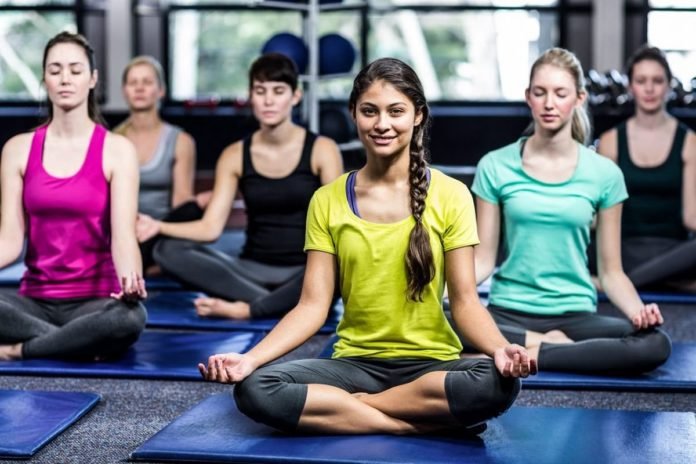The growing popularity of yoga has exploded in the US over the past decade making it easier for beginners to try their hand at it. However, as a beginner it can also be disheartening sometimes to start as a new student watching some fellow students jump into harrowing poses without breaking a sweat. Here are 12 things to consider before you decide to hang up your mat.
1. Everyone was a Beginner Once
It can be so disheartening to be struggling in a down dog and see the person next to you fly into tripod headstand without thinking about. The only difference between you and them is time. The very instructor teaching your class looks up to other yogi’s who can do things that they can’t! If you think yoga is beautiful and want to look like those you look up to, there’s nothing you can do but keep practicing.
2. Do Not Be Afraid to Use Blocks and Straps
I can’t tell you as a teacher how many times I see students sabotage themselves by refusing to use blocks and straps in class. It does not take away from the pose in the least if you need a strap to lock a bind or a block to reach the ground in triangle pose. Often times even for dedicated practitioners blocks and straps help them to achieve the optimal alignment in certain poses.

3. Find the Studio That’s Right For You
Some people hear the word “Om” and want to immediately run for the hills. Other people love the more spiritual aspects of yoga, while some prefer to focus on the physical aspects of the asanas. Either way, there is a studio that caters to the type of yoga that you prefer. It would be hard for anyone to go to a class they feel like doesn’t suit them and with the popularity of yoga now, no one has to take a class that isn’t what they’re looking for.
4. Find a Teacher You Love
There are many teachers to choose from at most studios, so make sure as a new student to try out all the instructors and find the one that you feel most connected to. You may still take classes with other instructors, but having a regular teacher to guide you through your practice as a new student is invaluable.
5. Find The Yoga That Speaks to Your Body
There are many types of yoga that are practiced today, traditional hatha yoga, vinyasa flow, gentle, and restorative just to name a few. Many people eventually find the type of particular class that works best for them and their bodies. If vinyasa is too fast and confusing, try hatha. It’s much easier to stick with yoga if you find the practice that works best with you and your preferences.
6. Don’t Be Body Conscious
We’ve all experienced the feeling of going to yoga on a bad day where it seems like the whole class is full of models, and you feel self conscious and uncomfortable. Try to leave those feelings at the door. Yoga is not about comparing yourself to others. It is a completely unique and individual experience. If you can let go of the feelings of insecurity you have your practice will take off, you will benefit mentally, emotionally, and physically.

7. Let Your Teacher Know About Injuries
Yoga teachers want and need to know about any past injuries their students may have. This way they can guide you in your poses so as to avoid pain and possible further injury. Many teachers will change the class at the last minute to accommodate any restrictions their students may have. In order to get the most out of any class, always let your instructor know what is going on with your body.
8. Don’t Eat Right Before Class
As with most physical activities, yoga is not meant to be practiced with a full stomach. If you’re eating too soon before class you will most likely experience discomfort in many or all of the poses. Don’t eat for the hour before class in order to optimize your experience.
9. Try Going With a Friend
Sometimes the fresh perspective of going to class with a close friend can reinvigorate you and your practice. Having a confidant for during and after your yoga experience can give you someone to bounce your thoughts off of and make you feel more connected to your experience in class.
10. Practice At Home
Home practice often gives us an opportunity to get deeper into our yoga without the added pressure of others being there. Without home practice, some people might not see their own growth and potential. Home practice is also a chance for us to work our favorite poses as much and as deeply as we like without having to follow a class format, which with invigorate the class practice that you do have.
11. Don’t Burn Yourself Out
It’s easy especially for beginners to burn themselves out in their yoga practice. Maybe you got a group on you want to make the most of, or are only paid through the end of the month at your studio. Taking too many classes in a short period of time will strain you physically and mentally, maybe turning you off from yoga for life.
Give your body time to recover after a class, especially if you’re new, and let class be something you look forward to, not something you force or take for granted.
12. Love Yourself
It’s all too easy to be super critical of ourselves today. Try to remember that yoga is something you do for yourself. It shouldn’t be a commitment or an excuse for you to verbally abuse yourself.
Everyone has to start somewhere, but looking at your progress over time, rather than just where you are at any given moment will give the perspective to feel self love and gratitude. At the end of the day that is yoga.











There are many times I’ve tried to do yoga but after few days I lose the zeal. Nevertheless it’s one of the best ways to stay fit.
Comments are closed.